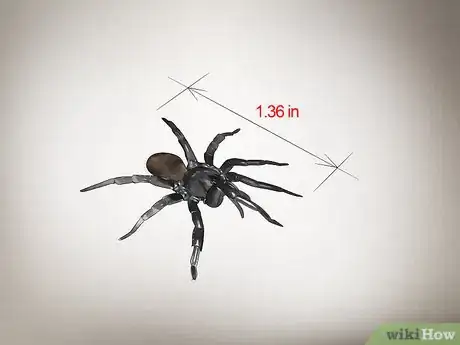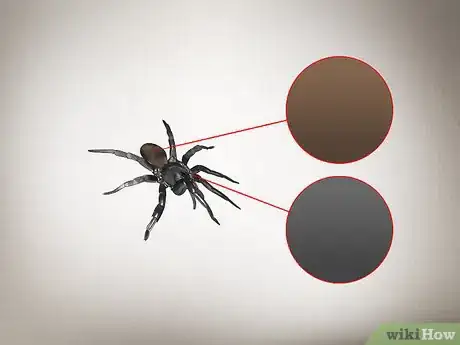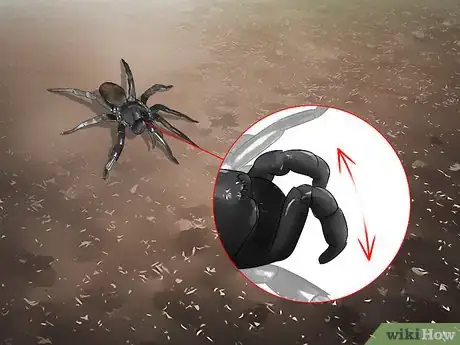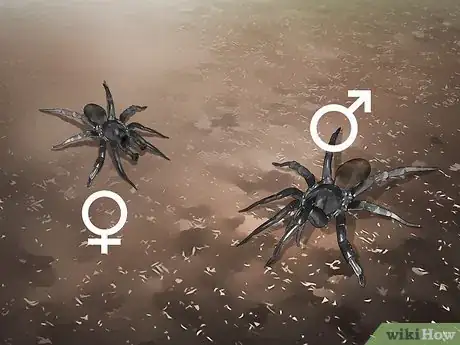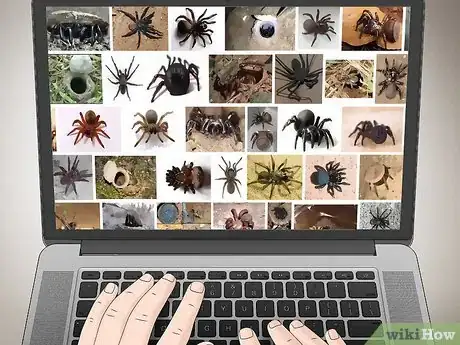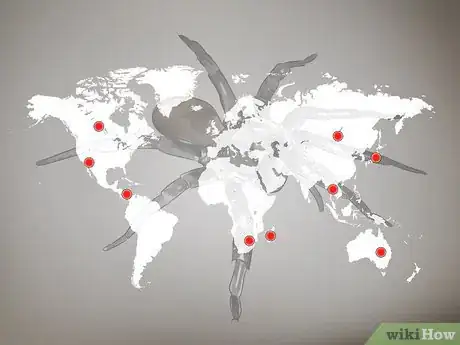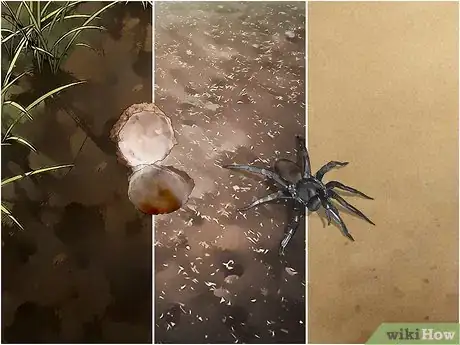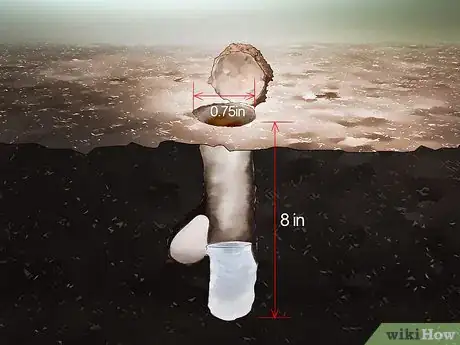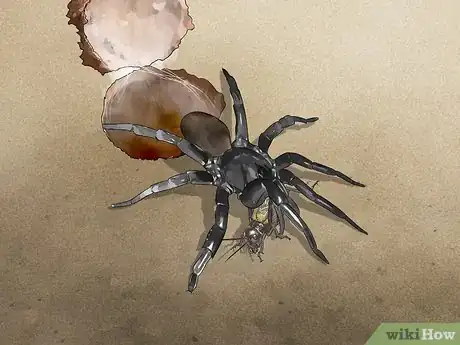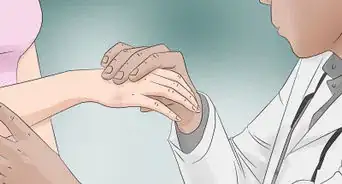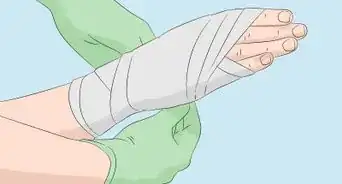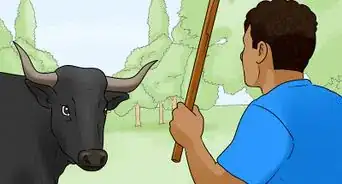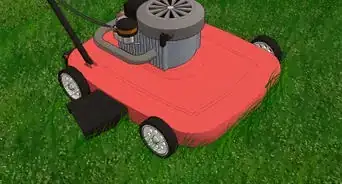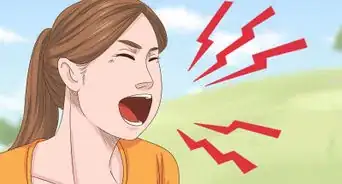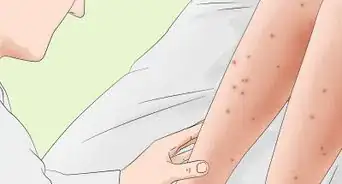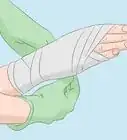This article was co-authored by wikiHow Staff. Our trained team of editors and researchers validate articles for accuracy and comprehensiveness. wikiHow's Content Management Team carefully monitors the work from our editorial staff to ensure that each article is backed by trusted research and meets our high quality standards.
There are 10 references cited in this article, which can be found at the bottom of the page.
wikiHow marks an article as reader-approved once it receives enough positive feedback. In this case, 89% of readers who voted found the article helpful, earning it our reader-approved status.
This article has been viewed 115,712 times.
Learn more...
Trapdoor spiders (family Ctenizidae) build silk-lined burrows in the ground with trapdoor covers made of soil and vegetation.[1] When the spiders feel vibrations caused by passing prey, they will leap out, capture the prey and take it down into the burrow.[2] The variety of burrowing species makes correct identification difficult, but understanding some common features and habits will give you general idea of how to determine if you have come across a trapdoor spider.
Steps
Identifying a Trapdoor Spider
-
1
-
2Look at the spider’s body. Trapdoor spiders are black or brown, with stout bodies and legs. Some species have paler color markings, or they may have a silky covering of hair. Their bodies are divided into two sections: the thorax (containing the head and legs) and the abdomen.[5] The abdomen is typically lighter and a slightly different color.Advertisement
-
3Watch the spider’s jaws move. The jaws of a trapdoor spider are attached to the front of its head. They move up and down, unlike most other spiders, whose jaws move side to side.[9]
-
4Look for gender differences. Females trapdoor spiders are larger than the males, but you will seldom see females because they rarely leave their burrows.[10] Therefore, if you see a trapdoor spider, it is most likely a male. Look for these characteristics that identify male trapdoor spiders:
- Short and blunt spinnerets. These produce silk, and are located at the tip of the abdomen.[11]
- A double spur about halfway along their front legs.
- A dusty or dull carapace (a harder area covering much of the thorax) that is lightly covered in bristles.[12]
- Pedipalps (small appendages near the jaws) that resemble boxing gloves.
-
5Expect variations. There are numerous varieties of trapdoor spiders, each with slightly different physical characteristics.[13] More varieties of trapdoor spiders are still being discovered. If you think you have seen a trapdoor spider, look up the specific varieties that live in your area, so that you know can what kind of specific markings to expect.
Recognizing Trapdoor Spider Habitats
-
1Know where trapdoor spiders are found throughout the world. The geographic distribution of trapdoor spiders is erratic and is attributed to the continental drift. Various species of trapdoor spiders can be found all over the world. Look for trapdoor spiders in:[14]
- North America: Canada, The United States (southeastern and pacific states, and north to Colorado)
- Central America (Guatemala, Mexico, etc.)
- Asia (China, Japan, Thailand, etc.)
- South Africa and Madagascar
- Australia
-
2Look for areas where trapdoor spiders like to burrow. Throughout the world, trapdoor spiders favor warm environments, such as temperate forests and deserts. They will burrow in grassy areas, hillsides, and dirt embankments.[15]
-
3Recognize the signs of a trapdoor spider burrow. Trapdoor spiders burrow in the ground (about 0.75 inches wide and up to 8 inches deep) and cover their burrow with a silken hinged “trapdoor” camouflaged by sticks, pebbles, and other natural material.[16] [17] Because the burrows are camouflaged, they can be very hard to see.
- Larger burrows may have multiple trapdoors.
- Usually, the burrow faces sunlight and will be found near vegetation.
-
4Look for trapdoor spider food. Trapdoor spiders are shy, may be nocturnal, and are rarely seen far from their burrows (males may wander during mating season, however).[18] You might be able to spy one, however, when it eats. The spiders will wait in their burrows until they sense vibrations in the ground caused by insects (including crickets, moths, beetles, and grasshoppers) and other spiders. Then, the spiders will leap out of the trapdoor, grab one of these animals, and drag it back into the burrow.
Community Q&A
-
QuestionDo trapdoor spiders climb up walls?
 Community AnswerTrapdoor spiders are ground dwelling. They cannot climb walls.
Community AnswerTrapdoor spiders are ground dwelling. They cannot climb walls. -
QuestionWhere are trapdoor spiders native?
 Community AnswerThey are from Australia, but they live in warm climates. They also are in several parts of Africa, Eastern Europe, Asia and certain parts of Mexico.
Community AnswerThey are from Australia, but they live in warm climates. They also are in several parts of Africa, Eastern Europe, Asia and certain parts of Mexico. -
QuestionAre trapdoor spiders venomous?
 Community AnswerTrapdoor spiders rarely bite; however, if they do so, it can be very painful. Their bites are not venomous, though.
Community AnswerTrapdoor spiders rarely bite; however, if they do so, it can be very painful. Their bites are not venomous, though.
Warnings
- Funnel-web and mouse spiders are often mistaken for trapdoor spiders.⧼thumbs_response⧽
References
- ↑ http://www.flaentsoc.org/arthropdiversity/florida_trapdoor_spider.htm
- ↑ http://www.stlzoo.org/animals/abouttheanimals/invertebrates/spidersandscorpions/trapdoorspider/
- ↑ http://www.ck12.org/book/CK-12-Understanding-Biodiversity/section/14.1/
- ↑ http://seawifs.gsfc.nasa.gov/jason/HTML/SPIDER_KEY.html
- ↑ http://www.uky.edu/Ag/CritterFiles/casefile/spiders/anatomy/spideranatomy.htm
- ↑ http://seawifs.gsfc.nasa.gov/jason/HTML/SPIDER_KEY.html
- ↑ http://www.flaentsoc.org/arthropdiversity/florida_trapdoor_spider.htm
- ↑ http://www.ck12.org/book/CK-12-Understanding-Biodiversity/section/14.1/
- ↑ http://seawifs.gsfc.nasa.gov/jason/HTML/SPIDER_KEY.html
- ↑ http://nathistoc.bio.uci.edu/spiders/Bothriocyrtum%20californicum.htm
- ↑ http://www.uky.edu/Ag/CritterFiles/casefile/spiders/anatomy/spideranatomy.htm
- ↑ Bond J, Godwin R (2013) Taxonomic revision of the Trapdoor spider genus Eucteniza Ausserer (Araneae, Mygalomorphae, Euctenizidae). ZooKeys 356: 31-67. doi: 10.3897/zookeys.356.6227,
- ↑ Bond J, Godwin R (2013) Taxonomic revision of the Trapdoor spider genus Eucteniza Ausserer (Araneae, Mygalomorphae, Euctenizidae). ZooKeys 356: 31-67. doi: 10.3897/zookeys.356.6227
- ↑ http://www.flaentsoc.org/arthropdiversity/florida_trapdoor_spider.htm
- ↑ http://www.ck12.org/book/CK-12-Understanding-Biodiversity/section/14.1/
- ↑ http://www.ck12.org/book/CK-12-Understanding-Biodiversity/section/14.1/
- ↑ http://nathistoc.bio.uci.edu/spiders/Bothriocyrtum%20californicum.htm
- ↑ http://www.flaentsoc.org/arthropdiversity/florida_trapdoor_spider.htm
- ↑ http://www.ck12.org/book/CK-12-Understanding-Biodiversity/section/14.1/
- ↑ http://www.termite.com/spider-identification.html
- ↑ https://www.catalinaconservancy.org/index.php?s=news&p=article_403
About This Article
If you think you’re looking at a trapdoor spider, first confirm the spider you’re looking at is about 1 to 3 cm long. However, to be absolutely sure you're looking at a trapdoor spider, and not another small spider, look at the spider's eyes. Trapdoor spiders have six eyes separated into three groups, whereas most spiders have eight eyes. These spiders also love warm places, so look out for them in temperate forests or deserts. For more tips, including how to recognize a trapdoor spider based on how it burrows, read on!
